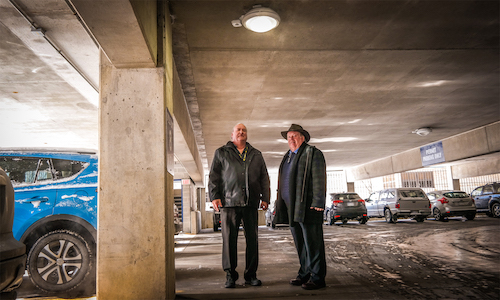
Jerry Van Couwenberghe and Kevin Headrick like to joke that the next time many of the light bulbs need changing at UM-Dearborn, somebody else is going to have to do it. They’re not trying to shirk their duties. They’re just doing the math: The LED bulbs they’re now installing across campus should last 10-15 years—at which point, these two veteran facilities guys suspect they’ll be kicking back in retirement.
Headrick said the long lifespan of the bulbs was a big factor in their decision to make the jump to LED lighting. The reason, he said, lies in a little-known secret about how big institutions typically change their light bulbs.
“Historically, large complexes have calculated that it’s smarter to replace their lighting all at once whether the light bulbs are out or not,” Headrick said. “They’ll project out the average lifespan of a normal fluorescent bulb, which is about three-and-a-half years, and then mass change everything out at three years. That ends up being a lot less work and money than having someone get on a ladder every time a bulb goes out.”
Switching over to LEDs could mean five times fewer trips up a ladder to change a bulb over a period of 15 years. That equates to a huge savings in labor costs for the university. Or, as Van Couwenberghe put it, “There’s a lot more to lighting than just the light bulb.”
There also are big savings to be had on the electricity bill since LEDs use about half the energy of even the most efficient fluorescents. For example, the LED conversion of the parking structure now saves the university around $21,000 in energy costs every year.
The university realized even more savings by taking advantage of incentives offered by DTE Energy to make the switch. When UM-Dearborn updated the lights in the parking structure, for instance, Van Couwenberghe claimed more than $17,000 in rebates for the university. The new walkway lights brought back another $4,000. In all, Van Couwenberghe calculated the university has earned more than $100,000 in incentives from DTE, much of it from lighting improvements.
Those savings, combined with the falling price of LEDs, added up to a strong business case for making the switch. The maintenance team and electricians have been hard at work on the updates since 2015, and Van Couwenberghe and Headrick estimate they’re about halfway to their goal of a total campus conversion. Places you’ll see the new lighting: The outdoor walkways, all the classrooms and the Fieldhouse parking lot.
As for the rest of campus, Headrick said as long as the technology keeps dropping in price, there’s no reason all of UM-Dearborn shouldn’t be lit up with LEDs by the time he and Van Couwenberghe are ready to hang up their ladders for good.


